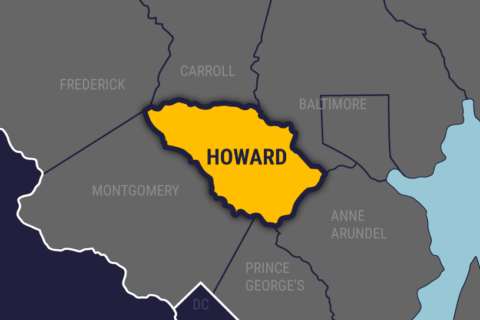With an eye to the sky and the 2020 calendar, work continues in historic Ellicott City, Maryland, to bolster the flood-prone tourist destination.
Four days after Monday’s torrential rains, a yellow excavator scooped up watery mud in a construction area near the recently completed concrete culvert at the intersection of Main Street and Ellicott Mills Drive. A 25-foot portion of Ellicott Mills roadway was washed away in the May 27, 2018, flooding, after an aluminum culvert installed beneath it in 1970 was overwhelmed.
In April, Ellicott Mills Drive reopened with a sturdy culvert — made of 57 precast concrete pieces, each weighing 23 tons — running below the road surface. The normally peaceful Hudson Branch creek runs through the culvert.
“We’ve replaced the culvert, and so we had to construct a new channel for the water,” said Mark DeLuca, deputy director of Howard County’s Department of Public Works.
Before the 2018 storm, the Hudson flowed in an underground pipe below Parking Lot F, near the intersection of Main and Ellicott Mills.
Construction crews are installing new sewer mains to replace those damaged in 2018, which has resulted in a temporary need to pump water from the culvert around the construction zone in smaller hoses, before dumping back into the channel.
After receiving more than an inch-and-a-half of rain in an hour Monday, the new channel, made of riprap stone, is holding up well with heavy rainfall, DeLuca said.
“We would have definitely had an issue if the old channel was in place, but this new channel will be able to hold it,” said DeLuca, gesturing toward the rocky pathway for the creek.
However, a few hundred feet downstream from the new culvert, one of Ellicott City’s most vulnerable flooding points remains — a 90-degree right turn at Court Street to pass under Main Street.
“We still have constrictions downstream from here,” DeLuca said. “So we are still wary of rain storms.”
The historic mill town has always been vulnerable to flooding. The Tiber, Hudson, Autumn Hill and New Cut branches flow through Ellicott City, which is located in a valley of the upper Western Branch of the Patapsco River.
In May, after devastating floods in 2016 and 2018, Howard County Executive Calvin Ball announced a long-term plan to reduce flooding in Ellicott City.
Under Ball’s plan, the county will purchase and demolish four businesses in the most flood-prone part of Ellicott City, on lower Main Street. An earlier plan called for the demolition of 10 buildings.
The largest and potentially most effective aspect of Ball’s $140 million plan is a still-to-be-designed tunnel that will carry floodwaters on the north side of Main Street and be discharged into the Patapsco River.
DeLuca said the tunnel will help alleviate the stress on channels that crisscross Main Street.
He expects Howard County will issue its requests for proposals for the tunnel project in the coming months, which would allow the county to view proposals by June 2020.
“When it’s all said and done, it will handle the 100-year storm, with that tunnel in place, and also the larger storms, like in 2016 and 2018,” DeLuca said.
After Monday’s storm, in which Ellicott City’s newly installed emergency sirens didn’t sound because of the heaviest rain’s location, the county and the National Weather Service told WTOP they are close to unveiling a new plan to clarify when the historic district’s residents and businesses are at risk for flooding.
Mike Hinson, acting director of Howard County’s Office of Emergency Management, and the weather service’s Jason Elliott said the new system is close to being implemented, and would differentiate Main Street from more rural portions of Ellicott City.
“What we submitted to the National Weather Service is ‘Historic Ellicott City,’ but I don’t know what it will end up being,” Hinson said.
Both Hinson and Elliott said they hoped to announce the new public notification policy in the coming days.







